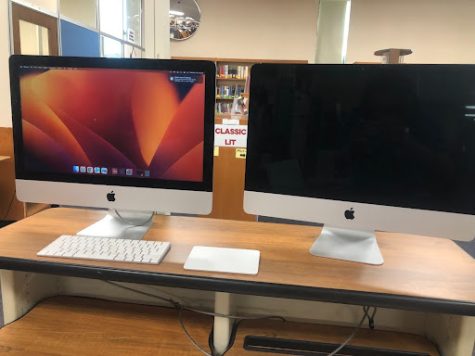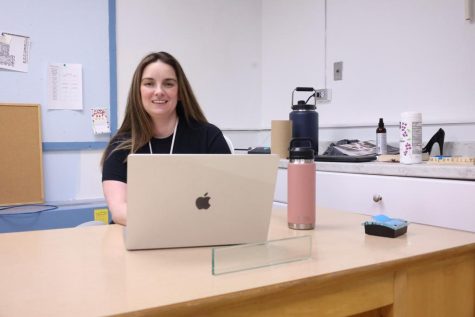Today’s library reflects digital evolutions
May 16, 2023
In an evolving world, libraries have taken on many new forms to serve modern student needs. While even more change is coming, the current state of libraries at schools like East offers a window into how learning takes place in a digital age.
In years past, one’s expectation that books would be the first thing one encounters when walking into a school library would be accurate. That is not the case today. Now, two large wooden shelves bearing laminated “Classic Lit” signs and holding titles like “Beowulf” and “The Complete Poetical Works of Shelley” can be seen — but only after traversing past or looking between two much different large objects, in this case iMac computers on rolling desks. The gleaming silver chrome that has become a signature of Apple products has come to be a signature of some libraries, too. The books are still here, of course; but in an apt metaphor, they are no longer quite the centerpiece of this space.

Students visit the library at East for all kinds of reasons. Its computer lab houses the school’s eSports team. The annex transforms into a cafeteria at 10:30 a.m. each day. Students come down for English classes, research projects, or just for fun. Perhaps most prominently, they come here to print.
Since 2019, when the library purchased a new printer for the annex, 1,319,550 sheets of paper have come out of the machine. This number is likely skewed downwards because large numbers of students were absent for many months of the printer’s presence, which largely overlapped with the COVID-19 pandemic. Cindy O’Reilly, the sole librarian currently serving East students after Greenblatt’s retirement, estimated that one fourth of the sheets printed were ordered by teachers. That leaves hundreds of thousands of sheets being printed by students every year.
While some traditionalists may view the increasing usage of libraries as technology hubs as a negative, Greenblatt and O’Reilly shared a different perspective.
“My hope is that bringing that technology piece along with the resource piece will help to cement us in the building,” said O’Reilly.
More and more, librarians are looking at technology as an anchor that can secure their status as necessary and useful parts of the modern school environment. The terminology “media center,” which is the official name of the library at East and many other schools, is one example of how librarians are using technology’s appeal in this way.
“Anything you can [do to] get people to walk through the door is going to help,” O’Reilly added.
By offering the appeal and convenience of technology, the media center can draw students in. They’ll come down to print a homework assignment or check out a Chromebook. On some special occasions, they might even be connected with the library’s virtual/augmented reality tools by their teachers. Then, O’Reilly and others hope, they’ll stay for a while, and maybe even check out a book.
Greenblatt estimated that before the pandemic, circulation might have included around 400 books being checked out by about 160 students in a school year. While COVID-19 affected circulation significantly and made it difficult to analyze clear trends and statistics about check-outs, one thing is clear: in today’s library, and even before COVID, relatively few students — likely less than 10% of the student body — are ever checking out a physical book.
“We have gone digital… we have the eBooks and the databases,” Greenblatt said, explaining how circulation has shifted from print copies to more online resources.
The library maintains access to more than 50 online databases and collections for student research. Ranging from coverage of global business issues to information on over 2,000,000 plant specimens, the resources are nearly endless. They offer students strong capabilities to find primary sources that go deeper than anything a Wikipedia article or even a single book could provide. Meanwhile, a growing collection of eBooks empowers students to read innumerable works of fiction and nonfiction on their electronic devices.
Nevertheless, the library’s print collection is far from gone. The East library owns approximately 20,000 books, and it continues to add around 200 selections every year. Currently, the new print additions are most often in categories such as popular fiction or graphic novels.
Some might ask why resources continue to be devoted to a print collection that seldom sees usage that reflects its full potential. Should 200 new books be bought in a year when relatively few — around 400 out of 20,000, pre-pandemic — of the existing books were checked out?
Staff and administrators in the Cherry Hill Public Schools appear to remain steadfast in their support of such investments. O’Reilly said that she hopes to increasingly incorporate students into the library’s book purchasing process in order to increase circulation and interest in the new books added to the library each year. She said that in future years, she may conduct surveys of middle school students to find out what genres and book series they are interested in; then, when those students reach high school, the previous few years’ book purchases would better reflect their interests. Such purchases would help get physical books in the hands of new students more often.

“I prefer to read something that’s in my hands,” said Dr. Joseph Meloche, expressing a sentiment that has helped libraries and bookstores persist in the digital age. “I like the physical experience that comes along with holding a book.”
Nonetheless, the library is on a path that, while maintaining traditional print expansions, meets students’ digital needs more than ever. This reality is reflected in the current budget of East’s media center, which looks significantly different than it would have before computers and printers were the central elements of a school library. Costs for digital media licensing — including databases, eBooks, and other digital resources — total approximately $30,000 per year at East, according to Mr. Lou Papa, an assistant principal at East who supervises the media center. He said that hard materials cost less than half of that, coming in at around $14,000 in a year. While Papa echoed the sentiment that physical materials will always be necessary in the school library, it is clear that the monetary trends are shifting towards a digital-first approach. Papa foresaw that funds could continue to shift, suggesting that the money freed by the decreasing costs of hard copies — if librarians choose to shift some funds towards other priorities — could eventually be spent elsewhere.
Libraries look very different today than they did 10, 20, and 30 years ago. In the next few decades, they are sure to evolve further. Advocates who hope to see libraries maintained in their current form may be discontented. However, for those who hope simply to see libraries stay afloat amidst national cuts and changing priorities — for those who hope to save libraries from their struggles, and possibly from extinction — the future could be promising.